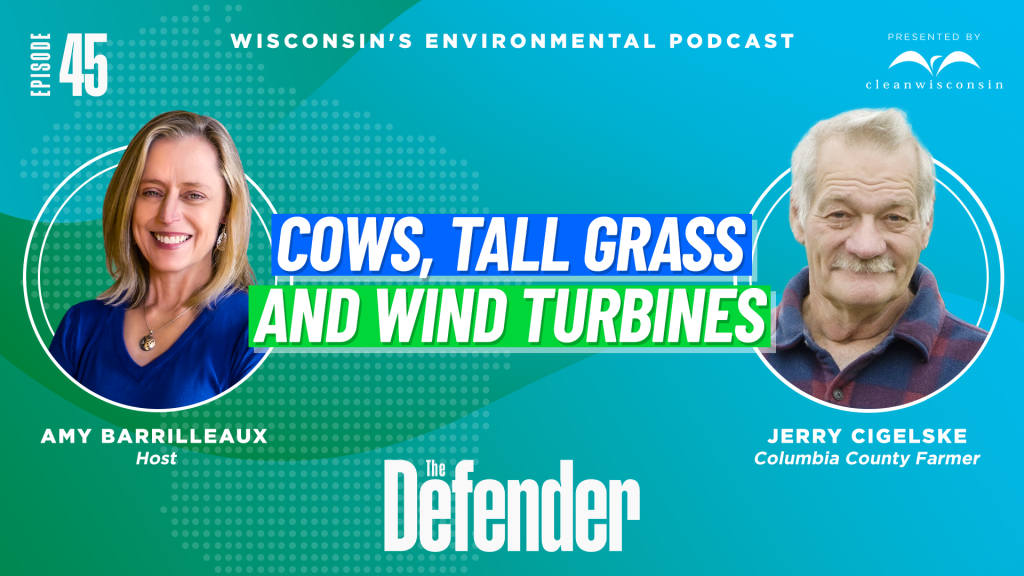Where to Listen:
Have you ever wondered what it’s like to stand next to a wind turbine? You’re about to find out. In this episode, Amy meets 2nd generation Wisconsin farmer Jerry Cigelske at his Columbia County farm to talk about why cows, grass and windmills have been the key to keeping his family on the land.
Host:
Amy Barrilleaux
Guest:
Jerry Cigelske, Columbia County farmer
Resources for You:
Showing up for Wind in Wisconsin
Cows in the Woods: What it takes to create a silvopasture
Transcript:
Amy Hello and welcome, I’m Amy Barrilleaux and this is The Defender, Wisconsin’s environmental podcast. The Defender is powered by Clean Wisconsin, your environmental voice since 1970. So I want you to take a second and picture a Wisconsin farm. I’m going to bet there are cows in there somewhere, maybe grazing on grass, maybe a little farmhouse where the farmer lives. The truth is that’s not really what a typical farm in Wisconsin looks like anymore. Cows are often confined. Family farms are being sold to large agribusinesses. The state lost 10% of its family farms in just five years between 2017 and 2022, according to census data, and that’s part of a long trend. But I recently met second generation Columbia County farmer Jerry Cigelske, whose farm looks a whole lot like that idyllic picture we have. Rolling hills, cows grazing in tall prairie grass, and he’s been able to stay on that land thanks in large part to income from four wind turbines on his property that have been there for the last 15 years. In this episode, I head to Jerry’s farm, get extremely close to a wind turbine, and talk with him about grazing, sustainability, and his philosophy on caring for the land. That’s right now on The Defender. Have you ever wondered what it’s like to stand next to a wind turbine? Well, I don’t have to wonder anymore because I stood right between two wind turbines during my interview with Jerry Cigelske as we watched his beef cattle graze around us and around the wind turbines. Jerry started off as a second generation conventional dairy farmer, got interested in grazing, then eventually bought farmland in Columbia County where I met him to talk about cows, grass, and yes, wind turbines! Thank you so much for taking me out here on your farm. I know farmers are busy, so I appreciate that.
Jerry It’s never ending list of things to do.
Amy So I want to paint a picture of where we’re standing. We’re standing between wind turbines and how many cows are out here?
Jerry About 40 cows, 40 cows with their calves.
Amy So 40 cows and their calves grazing in grass that looks like it’s about, I don’t know, two feet high.
Jerry Or at least that, yeah.
Amy So what prompted the switch, I guess, from being a dairy farmer where cows are, you know, largely kept in a barn and milked to being a grazing farmer where these cows are for beef?
Jerry Yeah, we had a confinement dairy farm and I was even planning on going to one of those big parlor and pre-stall setups. That was the goal and I got out of college. Every once in a while I’d read stuff in articles and farm magazines about grazing and I’m thinking, well, that makes sense, but all the experts say it doesn’t work. And so I just kind of passed it off and finally I had a feed consultant I was working with and she had other grazers and she kept insisting when I was on that rented farm that it was, that was a really ideal farm for grazing too. Lots of hills that were good and there was even some fences there from years ago and she said, you can even just give it a try. And so, I did and it took me three days. Decided I’m doing this the rest of my life. It cut labor costs just drastically. I said that the cattle were, they were just healthier. That showed even over time. The cost just, cost in so many ways just plummeted. Because I mean, yeah, their production went down some too, but with the lower cost, it still came out much better.
Amy What, to you, was the biggest surprise in this transition? Having been a farmer for all your life, the child of farmers.
Jerry I think, yeah, once I started with the grazing and we started, you know, we started questioning, why were we doing all this time harvesting the feed, hauling it in, taking the time to feed them, hauling the manure back out and we could have saved all this. And then it started making me question everything that we were doing as farmers. You know, is this making sense that we’re spending time on this or that? And it’s, we changed how we did things in the barn and everything because it’s like, this is labor intensive, why are we doing this? Isn’t there a better way to do this? And so it, yeah it just really opened up my eyes to to really start questioning things, to do some thinking outside the box to get more creative.
Amy Do you talk to other farmers about, you know, this experience that you’ve had and all the lessons you’ve learned?
Jerry I’ve talked to other grazers. That’s the interesting thing is confinement farmers, for the most part, they’re committed to their way of doing it. They’re not interested in switching. In fact, a lot of farmers, I mean, like I said, I was told when I was in college, that’s an old-fashioned way of doing it, that doesn’t work, you can’t do that anymore. And a lot farmers had that in their head, and my dad and my landlord up there are two perfect examples, so they just thought it shouldn’t be done that way anymore. It was an old fashioned idea. They were older, so during the 50s and 60s, when there was using pasture, but it wasn’t rotational graze, so it wasn’t as efficient. Plus they got the growth in farm machinery, the growth and controlled feeding systems and everything like that that was cheap at that time. Labor was cheap, so they could bring the cows in off of pasture, feed them in confinement, get more milk production, and it paid off good. But then by the time I was farming, the costs of all those things skyrocketed. The price of milk was almost unchanged. So in 30 years, it went from, yeah, it made sense to go to confinement then, to now it makes sense to go to grazing. But a lot of farmers just, either they’re like these really big farmers you see, they’re just committed to investing the money to have a concentrated feeding operation to get their return. And so it’s either that or we have grazers like me go the other way and we’re not pushing production, we’re pushing for low cost.
Amy So I guess, in a sense, this is kind of an old-fashioned farm because you have cows out on the land.
Jerry But it’s done more modernly because now we have electric fences, we got portable fences like right now, there was a break wire up here, I just moved that last night down here, it’s a matter of 10 minutes and I moved the break wire so they’re always controlling what they’re eating, and then in just a short time they get done with the pasture and then we move them off and then it has time to grow back, whereas the old way of doing it, they just had permanent pastures and the cows would eat all the good stuff until it was dead and the only thing left was bad stuff like weeds. And so now by doing it this way It’s just like harvesting hay, basically, but the cows are doing the harvesting
Amy So it’s a, I guess, a smart, more informed take on a practice that’s been around for thousands and thousands of years, which is letting cows out.
Jerry Right, yep, we have some modern improvements, and that’s why we have a grazing conference. Wisconsin’s had it now for, I don’t know, was it 30-some years. We go there every year and learn from other grazers about how you can manage better and make improvements and faster and make improvement on the cattle. So, yeah, it’s not like grazing was 30 years ago. It’s a new ballgame and done so much better.
Amy And I think, as we talk about moving to the future, the future of raising animals and animal health, we’re also surrounded by this sort of future of energy with these wind turbines everywhere. So tell me how you decided to host wind on this property.
Jerry Actually, they came to me, because there’s a project in this, a couple of townships here, they were doing 90 turbines all together, and because we’re up on a hill, it’s extremely windy, so it was…
Amy My hair’s all in my face right now, but…
Jerry Which is that’s why they they picked this area and we thought yeah that’s that would be a good fit because it’s you see the windmill they don’t they don’t take up much extra space the roads we’re standing on here was where i had cow lanes before so they’re actually an improvement over what i had without taking any extra space and the cows have a better place to walk on and there really wasn’t any downsides to it. It was just improvements.
Amy There was extra income, probably, for you. First of all, how important was that income to you?
Jerry Actually, it was crucial at the time because we had just had some health problems. We just went through another year of extremely low milk prices and we were basically having trouble with the bank. We needed a way to refinance and the fact that we could say that we’re going to have this income coming now for the next 30 years helped say yes, okay, we’ll do the refinance.
Amy So it helped keep you on your farm.
Jerry Yep, absolutely.
Amy Do you ever have people say, why would you host these things? They don’t belong on a farm or in a Wisconsin landscape or any of those other things.
Jerry When I was a young kid, every farm still had the frame left from the windmill. Every farm had windmills back then, and your average farm was 80 acres, which means a farm this size in this area would have been a couple different farms. You’d have two windmils just right there. And across the country, because everybody had cattle in those days. Everybody had windmill, so you’d look out and all you’d see is windmills. So really, it doesn’t change that much from 50 years ago.
Amy That’s a good point. Yeah, the windmill and the farm kind of like went together. We’re standing not, I don’t know, I’m not good at judging distance. How far do you think the closest windmill is?
Jerry That’s only maybe an eighth of a mile over to that windmill right there, yeah.
Amy Do they, do your cows, they don’t seem to be worried about it.
Jerry Oh, no never. Yeah, they walk right on you. In fact, they like on a sunny day They’ll they’ll stand under the shade from the windmill because it’s it’s a nice long column of shade and so they’ll stay in there.
Amy And you told me one story about the cows all lined up in the field?
Jerry Right, yeah, I come out to get the cows one time and I’m thinking why are they all standing in a perfect line? They never do that. They’re just spread out usually. And then I got closer, I realized they’re all standing in the shade from that windmill.
Amy I think we do hear a lot about wind turbines, that they are hurting your health, there are piles of birds under them, you know, all those things that I think when something new comes around or a new version of something, it can be a little scary. What has your experience been? I mean, do you see wildlife being harmed by the turbines or feel any ill effects or your cows for that matter.
Jerry Yeah, no. In fact, the interesting thing is, we’ve never had eagles in this area before. I mean, they were close by, with the Fox River close by. But I think they kind of migrated up the river, and we see them in this are now. So if they were killing birds, I don’t think we’d see eagles moving in. And the other thing, yeah, the deer, I mean I had a neighbor to the back at that time, who I thought was just gonna be a terrible, is gonna scare all the deer away. And then that particular night I was out – that was when they were first building them they just had the bases up and the and the part where they were gonna bolt the windmill to and it rained and so there was some water in the middle. I see a deer come walk up and drink water off of that base so just because it looks different it still wasn’t even scaring him away.
Amy I feel like deer are not scared of anything.
Jerry Yeah, no, we still have just as many deer here as we always did, so.
Amy When you talk to other farmers, I mean, I imagine at some point you’ve talked to other farmers who are interested in hosting wind turbines because it’s such an important source of income. What are the kinds of questions that you answer?
Jerry Actually, I don’t have too many other farmers ask about it. It’s usually people that are non-farmers. And it’s usually their biggest concern is I think it’s got to be so noisy, noisy in our neighborhood. And it’s, I mean, like I said, the closest one is about 2,000 feet from my house. So on a foggy day, if you’re outside, you can hear it. You go in the house, close the window, if it’s on that side, and you don’t hear nothing. So it’s just not an issue.
Amy Yeah, because you were telling me a story that, on a day like today, and it’s a little humid and cloudy but they’re not particularly noisy, but when it’s foggy you do hear it a little bit more because of the, tell me why?
Jerry There’s moisture droplets in the air and so the blades hitting those moisture droplets actually is what creates the noise, you know, banging into those moisture droplets. I had an engineer explain that to me that I knew. It makes perfect sense. That’s why the more moisture in the air the louder it gets.
Amy So I think you can say there is a noise associated with it when turbines are not totally silent. And on foggy days, there’s a bit more noise, but you’ve been OK.
Jerry Yeah, I mean on a day like this, once you get by the buildings you can’t hear them. They’re 2,000 feet away, you don’t hear nothing. I mean I hear more noise from the highway half a mile up.
Amy So, um, it’s interesting because you’re doing something that is old, right? You have cows out grazing on the property. You have windmills, just like a farmer 200 years ago might have. But do you feel like kind of like the modern version of that?
Jerry So, yeah, definitely it’s a new and improved version. I think, obviously, I’m a Christian, and so I always try to keep those values in what I’m doing. And so, yeah. I’m, instead of fighting with God’s creation, like corn farmers have to do, because that’s a monoculture. That doesn’t exist in nature, monocultures. You’ve always got to grow stuff. Well, I don’t have to worry about that in the pastures, anything grows out there. The cows eat just about anything except a few weeds. But it’s. And I don’t have to use chemicals to kill it, like crop farmers have to do. I don’t have to worry about insect problems. If there is an insect, like I don’t grow a lot of alfalfa, that seems to be the most problem one anyway. But there’s such a variety of things that if there’s an insect that attacks one species it never can attack all of them. And so there’s still always plenty growing there. So I’m just working with nature instead of having to fight it. And it just saves a lot work and a lot money.
Amy How big of a kind of revelation was that for you, to go from sort of conventional cows on concrete, monocrop agriculture to where you are today?
Jerry Yeah, it took a little time to accept that. Like I said, the experts said that doesn’t work. But yeah, the more I saw it, the more said, yeah, this is great. And I’ve been, yeah. Like all grazers, we try and promote it every chance we get to try and encourage farmers to switch, if they would. But even like, anybody new coming in, especially if they want to have a dairy farm, we say the only way you’re gonna do it is with grazing. Because you can’t invest in those big farm operations like the big ones have. But you can graze, you can even rent land. And start grazing cows for practically nothing.
Amy You make it sound so easy.
Jerry Well, as I said compared the conventional system, I think it is a whole lot easier.
Amy Well, it’s true. We’ve been standing here chit-chatting for 10 minutes and the cows are eating and the calves are out there. And, you know, it feels like they’re just taking care of themselves.
Jerry So yeah, as so now, we switched to beef. The calves just stay out here on the cows. And yeah, they’re just so healthy. When you have animals in confinement, that’s when you have a concentration of organisms that can cause disease and spread through the herd. But when they’re out here in the wide open with the air blowing through them, it doesn’t happen. Even when I first switched to grazing, when we had the dairy cattle, we put calves in hutches. We tried putting them out on the pasture on grass. Calves they’re being young they have a little more susceptible to having health issues and sometimes you treat them with antibiotics but I tried a couple times I would have two calves they were both kind of sick same time. I treat one. The other one I just moved the hutch to fresh grass and moved every day to a fresh grass. And the one that had fresh grass recovered just as fast if not faster than the one I was treating. I think there’s just something antiseptic about grass that just keeps bad organisms away and the cows just do better on it. That’s just my opinion but it just seems that way from what I’ve been through.
Amy No, I mean, that I think a lived experience says a lot. So, you know, I know managed grazing is starting to become more popular in Wisconsin. Like, what would you want to see for the future of farming in this state?
Jerry I would love to see a whole lot more dairy farmers switch, a lot more small farmers start up again and do the grazing. The biggest problem now is that milk processing places don’t want to mess around with small farms. So that’s almost the biggest challenge now to the small farmers turning out. But yeah, the grazing group, I belong to the state grazing group. They’ve started a grazing apprenticeship program. Young kids that want to get started, they work with a grazer over two years and learn a method and they can either take over that farm or then the farmer will usually help them get started on another one and we’ve expanded that program. There was a grazing school in Madison for a while, I’m not sure if that’s still going in or not, but yeah, that’s all the stuff that we’ve worked with to try and get more people into doing things this way.
Amy I wanted to come back to the wind turbines a little bit. It’s pretty windy here. You mentioned you’ve never seen a day when these wind turbines weren’t, unless it was too windy, but when it was not windy enough for these.
Jerry Occasionally they’ll be a few days when they’re off, but very often they’re running a lot. They estimate that when they build them, they figure that about 33% capacity is what they anticipate to get out of the windmills, and they set it between 35 and even 40 every year since they built them.
Amy So you’ve got plenty of wind.
Jerry So yeah, even better than expected.
Amy I do want to talk a little bit because we do hear a lot of like this is the closest I’ve ever been to wind turbines. We walked right beneath one which made me nervous and you weren’t nervous.
Jerry Oh no. Yeah, no, they don’t bother me at all. I’ve seen the villain. They’re solid. They are not just going to fall over.
Amy But so there are a lot of myths, because I think people can rarely get up this close to wind turbines. So do you see, for instance, piles of birds under the wind turbine blades?
Jerry No, I’ve never seen that. I have seen a couple occasionally, but I don’t really see a whole lot of problems. We’ve got birds all over the place around here, even hawks. We’ve always had hawks around here. They fly higher. We have eagles now that we didn’t have before, they fly higher, and so it doesn’t seem to be a serious problem. Maybe they’re just smart enough to detect the motion and stay out of the way.
Amy They’re not moving very fast, I’ll say.
Jerry Only has a 14.4 RPMs, so that’s pretty slow.
Amy Alright, well you got the knowledge. I guess when you live among wind turbines, you learn all about them.
Jerry When they built them, for every day, once a month, they would get us together and they would give us basic information about them, so we would know more about them too. So we’re not asking questions and stuff, and then we were comfortable with them by knowing more about them too. So yeah, they were very good about educating us, and they always had a hotline number if we had any concerns, any questions, we could always call and they would respond right away. So yeah they’ve been very good to work with.
Amy How often have you had concerns?
Jerry Really nothing too serious. I know one time I went out one morning, and I’m thinking that windmill is making noise. That sounds like a bearing going off, if it was a piece of my farm machinery So I called them right away, and yeah sure enough they were out an hour later, and they had it shut down They were up there working on it, so apparently there was something wrong. But yeah, same thing with equipment. You catch it quick. You can usually fix it easier, too. But yeah I know we haven’t really had I guess there was one way over the other way that had a fire I think it was probably lightning that that did cause We had a tornado go through the woods actually, so it would have been really close to these two windmills here, and they, they, I’m unaffected, there wasn’t any problems. There’s trees down all through the wood, and a big one over there, but the windmils were unaffected, so they were built, they were build to handle that. My wife said about beging out in storms, you know, when you’re out in the open on a tractor, something worrying about getting hit by lightning, and I said I’m not too worried about that anymore, I got these 250 foot lightning rods all around the farm.
Amy That’s true, it’ll be them first.
Jerry Right!
Amy So if you could say anything to somebody who, you know, is either thinking about, because you have these two cool things going on on your property. You’ve got really happy looking grazing cows and calves, and you’ve got wind turbines that’s kind of helping you do this, helping you stay on the land and do this. If you could tell somebody about why it’s important to do these things I mean, what would you say?
Jerry Yeah, I think it’s a good use of the land. I’m certain that grazing is by far, as far as I’m concerned, the only way anybody should be having cattle. I mean, I know a beef farmer in the other side of town here that’s got, he doesn’t even know how many cows he had when I asked him, and he grazes everything, too. And he said, too, we’ve got to work together because most people don’t understand us. It’s just a much better system in so many ways. The experts don’t, actually, part of the problem is these conventional farms, they can buy seed every year. They buy chemicals every year, they buy a fertilizer every year. We buy next to nothing of any of that and so they don’t want you doing it because they can’t sell stuff to farmers. I got this picture of a farmer with overalls and there’s hands in every one of his pockets. And that’s what it’s like on a conventional farm. I don’t have that anymore. I got rid of that. Nobody comes and looks to me for money because there’s nothing they’re gonna sell me. And the few things I do need I’ve got good people I work with and and they understand what I’m doing and so yeah, it’s… It’s just so much better. And yeah, the windmills, they were just nice, really a nice addition. They said they gave us nice roads. They don’t really interfere with much of anything. The people that we work with, they bend over backwards to accommodate for me. In fact, they said most of their farms, they’ll just run to save money, they run roads directly from one mill to the next. For me, they actually bent the rules a little bit and put them where I already had driveways and cow lanes and not have to cut across where I had fences. And so like I said they were really very accommodating.
Amy And plus, you talked about the hands in the farmer’s pockets and buying things like chemicals and things like that. You have, we were talking, plenty of birds now and pollinators here. Like there’s all kinds of native plants and grasses growing.
Jerry Oh, right, yeah, for a while there, I think every day for a month I picked a different flower I’d find out in a pasture and take it home to my wife, because there was just that kind of a variety. I seem them taking pictures of this weed bed over here that’s got really pretty flowers on it.
Amy That’s great, and the cows like to eat everything but thistle, I guess.
Jerry So yeah, pretty much, there isn’t much, they go for burdock right away, actually, so yeah, and they’ll eat the buds and blossoms off of flowers for the extra sugar that’s in them, which is good nutrients for them, so it’s rotated through, so there’ll be a month or more before they come back to the same pasture, so by that time everything’s kind of grown back and doing fine, if not, the old permanent pasture style, they graze good stuff until it was dead, because it just can’t handle constantly being eaten off every two days. But this system is just like mowing hay, they graze it off and then it grows back.
Amy Well, Jerry, thank you so much for, you know, bringing me out on the farm and showing me this kind of beautiful space and really talking about your philosophy about the land and how to be a part of nature instead of fighting it. I really appreciate it.
Jerry Oh, you’re welcome. I’m glad to, anytime I’m always glad to promote grazing.
Amy And thank you for listening to The Defender. If you like the show, please take a second to rate it and leave a review or comment on your favorite podcast platform. It helps other people find us. And for more information on wind projects in Wisconsin and how you can plug in to help support them, visit cleanwisconsin.org. I’m Amy Barrilleaux, talk to you later.





